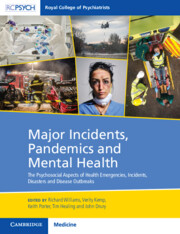 Major Incidents, Pandemics and Mental Health
Major Incidents, Pandemics and Mental Health from Section 3 - The Role of the Public in Emergencies: Survivors, Bystanders, and Volunteers
Published online by Cambridge University Press: 11 January 2024
Large-scale incidents that involve chemical, biological, radiological, or nuclear (CBRN) material, whether accidental or deliberate, remain a high-impact public health threat. This chapter describes research in which the social identity approach has been applied to examine the psychosocial aspects involved in the process of decontamination. It focuses on the willingness and ability of members of the public to undergo decontamination. This research programme highlights the role of social identity in shaping public behaviour and affecting public health outcomes during incidents involving mass decontamination. It identifies that, during incidents requiring decontamination, the relationship between responders and members of the public is likely to play a key part in shaping public behaviour. It proposes that effective communication must begin prior to an incident occurring, continuing into the early stages and throughout the duration of the incident. It also proposes several actions that responders should take to facilitate the decontamination process and its outcomes.
To save this book to your Kindle, first ensure no-reply@cambridge.org is added to your Approved Personal Document E-mail List under your Personal Document Settings on the Manage Your Content and Devices page of your Amazon account. Then enter the ‘name’ part of your Kindle email address below. Find out more about saving to your Kindle.
Note you can select to save to either the @free.kindle.com or @kindle.com variations. ‘@free.kindle.com’ emails are free but can only be saved to your device when it is connected to wi-fi. ‘@kindle.com’ emails can be delivered even when you are not connected to wi-fi, but note that service fees apply.
Find out more about the Kindle Personal Document Service.
To save content items to your account, please confirm that you agree to abide by our usage policies. If this is the first time you use this feature, you will be asked to authorise Cambridge Core to connect with your account. Find out more about saving content to Dropbox.
To save content items to your account, please confirm that you agree to abide by our usage policies. If this is the first time you use this feature, you will be asked to authorise Cambridge Core to connect with your account. Find out more about saving content to Google Drive.